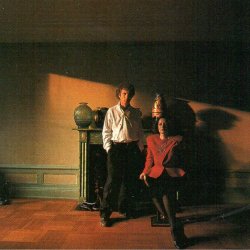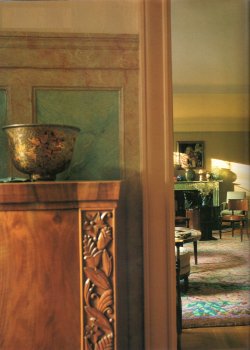In their New York gallery, Andrew Solomon meets Haim Manishevitz and his wife Audrey Friedman, untiring collectors of art deco, and inveterate anecdotalists.

Haim Maneshevitz and Audrey Friedman in their drawing-room.
Haim Manishevitz comes on strong. He’s aggressive, assertive, rather insistent and a touch arrogant, as though the possibility of being wrong is not one that frequently crosses his mind. And yet in spite of all that, he’s rather charming, and one ends up being convinced. Haim Manishevitz used to be in marketing, and I’ll bet he was good at it. His wife, Audrey Friedman, used to be a social worker, and I’ll bet she was good at that. Their apartment used to be a mess, badly painted, badly furnished, dark and gloomy, and I’ll bet it was perfectly awful. Nowadays, he and she run a gallery, Primavera, which specialises in deco furniture, and nowadays their apartment is spectacular, open, elegant, mannered, formidable and chock-a-block with priceless deco, most of it French.
They live on West End Avenue and 105th Street, which is the sort of neighbourhood in which we are all now willing to venture with a modicum of cautious good sense. But they went to live there in 1979, when mothers told their children not to walk through such areas if they valued their lives, when the area was full of restaurants that many people entered and from which few people emerged. When I asked Haim Manishevitz whether he’d been afraid at all when he moved in, he slapped his knee and leapt up. “It was not dangerous,” he said. “West End Avenue was always a beautiful street. When we moved in Broadway was slightly sleazy, but just slightly so. East of Broadway, on Amsterdam, it was the war zone, but here on West End Avenue it was always beautiful.”
When they moved in, the New York critic and intellectual Norman Podhoretz had been living in the apartment for 30 years. Haim Manishevitz and Audrey Friedman trip over one another trying to describe how awful it was. “The intelligentsia resist vanity,” she explains, indulgently, but he interrupts. “It hadn’t been painted once in 30 years,” and she concedes that “everything was that mustard yellow that things turn after a while, and the kitchen floor looked like archaeology, worn back to various levels. Podhoretz made this into a schlumpy big apartment.” Manishevitz shakes his head again. “Books, books, books, books, everywhere there was nothing but books!” He shivers slightly. “It was disgusting,” he says, and she says, “if they were happy in it that way, why not?”
Despite all this, the structural elements were in good order. “We decided to redo the entire kitchen when I opened a drawer and found it full of disintegrating cockroach eggs,” says Audrey Friedman. But other than that, “all we really needed was a major paint job,” says Haim Manishevitz. “But major. It was the kind of job on which you couldn’t even get an estimate; you would scrape the paint off the ceiling and the plaster would begin to fall down. So I got a painter and I said I’d pay him by the day, a little Greek man, Steve, and he said, “I’ll have your apartment done in about three weeks, for about $3,000.” Three weeks later Steve said to me, ‘It’s a lot of work, this apartment’.” “It was disgusting,” says Audrey Friedman. “It went on for six months while we lived in one room, out of packing-cases. I finally went to Europe to get away, and stayed there for five weeks.”
When they moved in, it was 1979, and open spaces were all the rage. Friends kept suggesting that they put together some of the grand rooms in the apartment, and give it some unity. “They said to me, ‘Why don’t you tear down walls and get views, so you can see from your living-room into your kitchen?’ And I said, ‘Damn it, I don’t want to see from my living-room into my kitchen. When I’m in my living-room I forget I have a kitchen. And besides, I don’t want everyone else looking from my living-room into my kitchen. If I wanted a loft, I’d have moved to Soho’.”

The view from the dining-room into the living-room. The fireplace is of marblised wood; some of the furniture is permanent, some of it just passing through.
How right they were! Under Norman Podhoretz’s depressing grey wall-to-wall carpeting they discovered old parquet floors with elegant detailed borders; the rooms have wonderful proportions, richly satisfying to the eye, and they open into one another suavely. They are certainly large enough as they stand, and their quiddities are part of their charm. “What is wonderful about this apartment,” says Audrey Friedman, who understands about luxury, “is that it has so much useless space. Corridors, little entrance ways into various rooms — and that’s a wonderful thing to have in New York today. It’s nice to have some small spaces to play against the large ones, instead of having everything like a barn.”
Some of the spectacular furniture is in the apartment to stay, but some of it is gallery material in transit, living on West End Avenue until there is space to display it on Madison. The gallery was Audrey’s idea, with her first husband, and it began as a way to underwrite their collections. “When I was a little child,” explains Audrey Friedman, “I would go to visit my aunt, and she had a piece of glass, a small vase that had belonged to my grandfather, which I in fact now have, and I thought it was magic. Years later, when the mother of my fiancé had some similar glass, I became terribly excited, and after I was married we would put all our money into iridescent glass. And then we would come across pieces we liked better than the ones we had, and so we would want to sell some of them off, so we started doing a little selling.”
Their gallery is now one of the top ones in New York for deco furniture; only Modernism and De Lorenzo are comparable. And of the three, Primavera is the oldest. “We were glad when the others came along, glad not to be the only deco dealer, glad to see that someone else had faith in the period. Our relations with the other galleries are very amicable, and we do a lot of business together,” says Haim Manishevitz.
Originally, the gallery was full of Audrey’s much-loved iridescent glass, and other art nouveau, but “after my first trip to Europe, after I saw Ruhlman and Charon, I just couldn’t look at art nouveau any more. It all seemed so superfluous. What you saw then in art deco in the USA was so unappealing, but the French material was phenomenal. We started out buying the best we could afford, and each time we went on a buying spree in Europe we would upgrade a little. Each time we would pay for something more expensive than anything we’d ever bought, and then we’d look at one another and say, ‘We’re still alive and we have it’.”

This fabulous sofa by Pierre Chareau, in the original fabric, is one of the high points of the collection.
Haim Manishevitz and Audrey Friedman like stories, and they like telling stories. In their big, slick living-room, with its marblised green fireplace (“there was a crazy little old Italian marlbiser…”), with its multicoloured rug (“how we got that rug is another story altogether…”) and its wonderful desk (“we’ll never part with it, but let me tell you what someone once said…”), the reminiscences pile on top of one another. For every question, by way of an answer, there is a story.
“That,” says Audrey Friedman impressively, gesturing at a table of fabulous beauty, oblong, its surface dotted with stars, “is an Eileen Gray table. The London dealer who had it when we bought it said it cost $15,000. And this was some years ago, when $15,000 was an expensive table — but what a table! I thought it was strangely cheap, really, and I said to that dealer and to my friends in London, “Why hasn’t it been sold?” And I was told that the only collector in London for Eileen Gray didn’t want it for some reason, and that none of the dealers were willing to take a chance on it. And I thought — ‘How foolish!’ And I bought it.”
Audrey Friedman gazes fondly at the table. “Some people from Texas,” adds Haim Manishevitz, “wanted to buy it recently, and they offered us a lot of money for it. We were sad to see it go, but it was a lot of money. And then she said to him, ‘Honey, will it be the right height for people to put their drinks on at a cocktail party?’ And we looked at one another and said, ‘It’s not for sale’.”
I ask them how they feel about the people who drift in off the streets to look in their gallery, and it is Haim’s turn to tell a story. “If we see somebody who has real interest and love, even without money, and is curious, we will always try to welcome them. If someone comes in and asks a lot of stupid questions, you ultimately have to be rude. If someone has a sophisticated interest, even if they don’t know…” Audrey interrupts him, “D’you know what a yenta is?” (For those of you who don’t, a yenta is someone who babbles on and on in a relentless sort of way.) But Haim is telling a story. “There was an old couple who used to go into all the dealers to ask questions, and everyone was rude to them except Minna Rosenblatt, and she was always very nice to them, even when they came in and asked questions and didn’t buy. And several years later, the guy came to her gallery, it was in the morning, and he looked around and asked some prices as he always would, and then he said, ‘I’ll take it all. Deliver it to my jet tomorrow’.”
Meanwhile, Audrey Friedman and Haim Manishevitz are at the front on the great wave of rediscovering the fifties. “Like the deco, the Fifties things in this country are terrible, and some of the stuff from Europe, the Danish things are awful. But there was wonderfully exciting work going on in Paris and Italy. There are wonderful examples of pieces with great spirit, and only the most sophisticated collectors have started buying them, and only in the last four or five years.”
“What we really love,” explains Haim Manishevitz, “is to love things, because that is part of the joy in life.”











